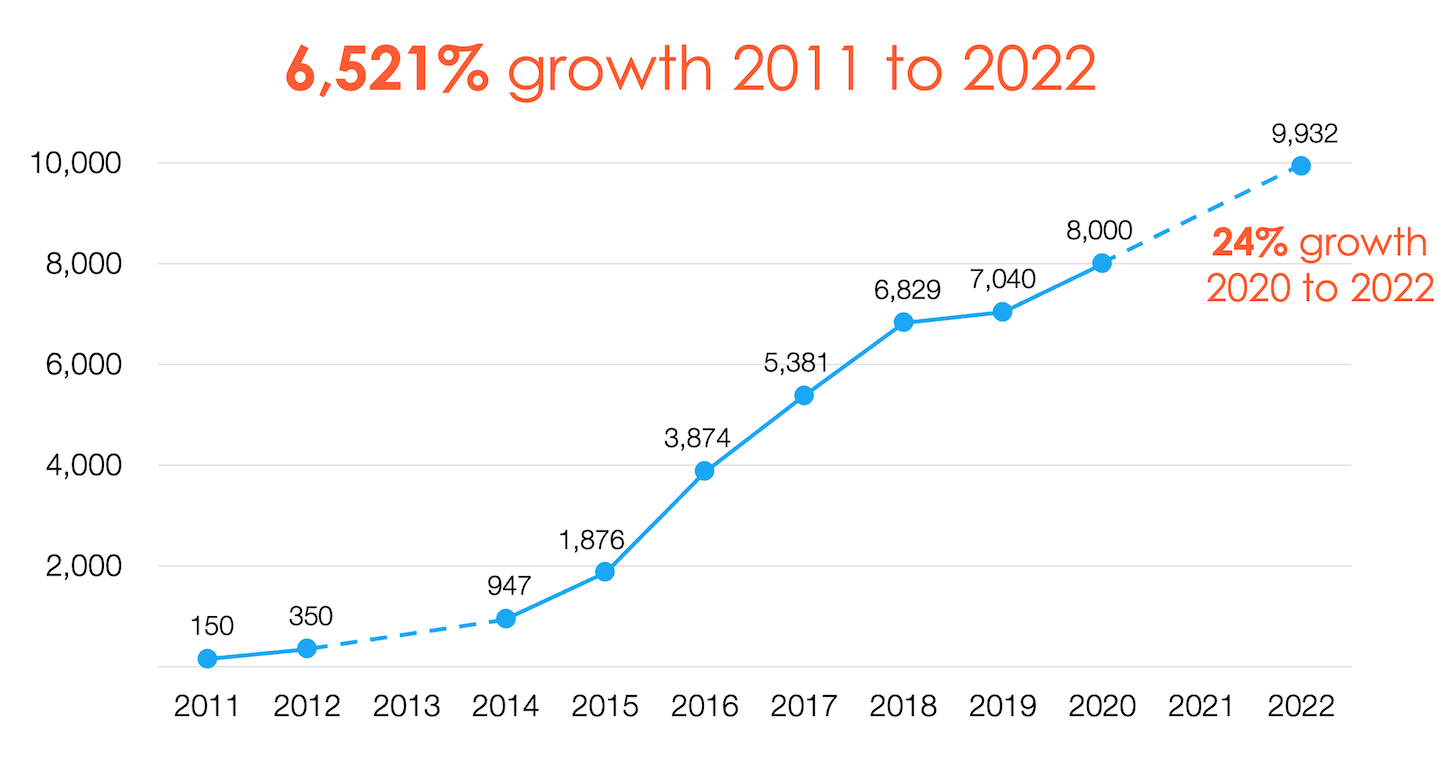Short for marketing technology, martech refers to the interconnected apps that help businesses automate, analyse, and manage their marketing, sales, service, and operations. These apps fall into six broad categories:
1. Advertising and promotion – e.g. display and programmatic advertising, mobile marketing, native/content advertising, PR, print, search and social advertising, and video advertising.
2. Content and experience – e.g. content marketing, CMS (content management system) and web experience management, DAM (digital asset management), MRM (marketing resource management) and PIM (product information management), email marketing, interactive content, marketing automation and campaign/lead management, mobile apps, optimisation, personalisation and testing, SEO, and video marketing.
3. Social and relationships – e.g. ABM (account-based marketing), call analytics and management, customer experience service and success, influencers, CRM (customer relationship management), advocacy loyalty and referrals, community and reviews, events, meetings and webinars, social media marketing and monitoring, and live chat and chatbots.
4. Commerce and sales – e.g. retail, proximity and IOT (internet of things), affiliate marketing and management, sales automation enablement and intelligence, eCommerce platforms and carts, eCommerce marketing, and channel partner and local marketing.
5. Data – e.g. marketing analytics performance and attribution, audience/marketing data and data enhancement, IPASS cloud/data integration and tag management, business/customer intelligence and data science, DMP (data management platform), dashboards and data visualisation, governance, compliance and privacy, mobile and web analytics, and customer data platform.
6. Management – e.g. agile and lean management, collaboration, talent management, budgeting and finance, projects and workflow, product management, and vendor analytics and management.
Read more: The future of business: data and digital transformation
In the last decade, martech has undergone a boom period. In 2011 there were approximately 150 martech apps; in 2022 that number has grown to nearly 10,000[1] (that’s over 6000 per cent growth in 11 years). The last two years have seen particularly rapid growth (24 per cent from 2020 to 2022) thanks to the pandemic hastening digital transformation within business and accelerating the adoption of eCommerce among consumers.
See the latest map of martech apps here.

[Brinker, S. Growth of the Martech Landscape 2011-2022. Source: chiefmartech.com]
Martech and AdTech (advertising technology) are not the same thing. While martech encompasses apps that help you manage, analyse, and automate your brand, AdTech specifically focuses on apps that help promote your offerings and influence behaviour. In short, AdTech is one aspect of the larger martech landscape.
Read more: Technology adoption in 2023: What are businesses investing in?

Aside from enabling more efficient use of time and resources, martech is empowering businesses to connect customer experiences across platforms and customer touchpoints, run omnichannel marketing and undertake data-driven decision-making.
What differentiates martech apps from regular programs and dashboards are their ability to integrate with other systems, allowing information to transfer across various marketing channels, platforms, and customer journey touchpoints. In other words, martech helps break down information silos, be it between departments or between platforms. The result is not only better customer experiences and personalisation, but from a business side, a more rounded understanding of your customers. The more data sources you have building your customer understanding, the more holistic it will be.
Read more: Digital disruption: how to excel in digital customer experiences
Martech is a key enabler of omnichannel marketing, which focuses on integrating a brand’s various channels to provide consistent and frictionless experiences as consumers
move from one channel to another. In the case of martech, these channels can include a brand’s website, social media, email, online advertising (Google ads, Facebook ads, LinkedIn ads etc), chatbots, customer service portals, apps, as well as augmented and virtual reality activations.
One example of omnichannel marketing in action is businesses tailoring their promotions according to your past interactions with their brand. Netflix, for instance, will promote new shows in-app and via email based on the content viewers have previously watched. Moreover, it offers the same tailored experience regardless of how a user accesses the service, be it from a browse, smart TV or via a mobile device.
Read more: Customer experience in the age of martech
The benefit of having so many apps working together and sharing information is the insights it generates. As well as providing holistic 360-degree views of your customers, you can also gain insight into the behavioural habits of your customers, from when and where they shop to how much spend, their favourite products and what sales/promotion offers they engage with. All of this provides a rich background with which to understand your customers, allowing you to make strategic and business decisions based on data and insights rather than gut feel.
Read more: Get data smart: an introduction to data science

When a business uses a group of martech apps this is often referred to as a martech stack or ecosystem. While martech stacks will vary depending on your business type, complexity, size, goals and KPIs, they usually include the following foundations:
In addition to this foundation, businesses may opt to use additional “addon” martech apps to aid specific parts of their business. This might include a data management platform (DMP), a customer data platform (CDP), a tag manager, analytics, brand tracking, social media monitoring and automation, A/B testing, AdTech, or a loyalty programme manager.
Read more: What it takes to be a technology leading business
Who is your target audience? What does their buying journey look like? Identifying who your brand/product will appeal to and understanding what their touchpoints with your business will be will allow you to find opportunities where martech can ensure a smooth flow of information between points in their buying journey and a seamless experience of your brand.
Related content: Free Customer Journey Map Template
What are your key performance indicators? Are you trying to sell X number of units? Increase repeat shoppers by X per cent? Or achieve consistently high Net Promoter Scores (NPS) from your customers? These can often dictate what martech you use. For example, Customer Monitor is a surveying tool that allows you to track and measure your NPS and customer experience. If maintaining an NPS of +30 is one of your KPIs, this would be an ideal tool for your martech stack.
Read more: What are the brand tracking KPIs for a brand manager to monitor?
What tools and expertise do you already have? How well are they performing? Are they capable of scaling with your business? Consider how your current technology will help you meet your KPIs and business goals. Are there any areas where tools or expertise are missing?
Tip: A Voice of Customer programme that collects customer feedback is an excellent way to assess how your current processes, tools and expertise are meeting the needs of your customers and identifying areas for improvement across your business.
Consider how each step of your customer journey could be enhanced with martech, from tools to help manage, monitor and analyse your brand to delivering better experiences.
Also consider automation and what repetitive tasks you could offload onto a martech tool to free up your staff to spend more time serving customers, innovating, and problem-solving. If you have automation capabilities in your business, are they being used to their fullest potential? Is the tool you are using meeting your needs?
Read more: Reveal your brand’s weaknesses with a customer journey map

Martech is a fast-evolving industry, and it is only set to change and grow further as consumer needs, expectations and technology change. But for now, here are the current trends we’re seeing.
With the pandemic driving consumers online, eCommerce has seen a sharp increase in the last few years as brands and businesses were forced to follow. A 2022 report found that New Zealand’s eCommerce has grown by 52 per cent since 2019. Moreover, it’s expected to grow an additional 38 per cent between now and 2025. With more and more businesses doing business online, the need to build superior digital shopping experiences has grown. In fact, eCommerce has been so successful it recently surpassed in-person as the most effective channel for B2Bs.
Digital self-service is rapidly becoming preferred over human interaction, be it in person or remotely via a video or phone call. A consumer report of US and UK participants found 81 per cent of consumers say they want more self-service options. Interestingly, only 15 per cent expressed a high level of satisfaction with the tools provided to them.
With Digital self-service offering greater flexibility, accessibility and safety, it’s no surprise that customers want more of it. However, research shows businesses still have some way to go to make the experience as frictionless as consumers would like.
From handling customer queries to surveys to cart abandonments, upselling and discounts, chatbots are becoming a key tool in many a martech stack, particularly for customer service. Capable of complex troubleshooting, AI chatbots can offer instant, 24/7 support to customers whenever they need it. And customers are quickly adapting with 62 per cent preferring to use a customer service bot rather than wait for a human agent to respond to their question and 45 per cent expecting an instant response when querying a chatbot.
In short, chatbots are enabling fast, efficient customer service and complaint resolution.
However, this technology is also causing significant disruptions that businesses should be aware of, monitor, and respond to. For example, the release of ChatGTP and Google's Bard, among others, are set to change the way we find information online. In turn, this could see businesses needing to change their approach to search advertising. Similarly, AI chatbots are disrupting the education sector as students use them to learn and write, which could see a rethink on how the sector teaches and tests in schools and tertiary education.
Overall, AI chatbots offer huge potential for businesses to revolutionise their processes and customer service touchpoints. However, the extent of this technology's (often inadvertent) disruption is still relatively unknown and it is likely to bring about new changes in consumer behaviour, which businesses will need to be ready to adapt to.
Various social media monitors and schedulers are providing powerful analytics on your brand’s social performance. These apps not only save marketers time by aggregating all their social media content into one place but also help marketers test and improve the effectiveness of their social campaigns and content with in-built analytics.
While not as new and shiny as the other items on this list, the humble email still has a lot of staying power when it comes to marketing communications—doubly so when it’s automated. Email workflow automation allows businesses to nurture prospects over a series of days, weeks or months, depending on your business’s need, with very little input beyond its initial setup. Add in personalisation and smart content tailored to buy persona tastes and email automation apps, such as HubSpot and MailChimp, are powerful martech tools that free up your marketing team’s time and keeps your brand top of mind as well as at the top of their inbox.
More often than not, programmatic advertising is a key part business’s AdTech stack. Programmatic advertising tech allows advertisers to automate the buying and targeting of their online ads. Rather than having to contact every website and app directly, programmatic advertising platforms offer one place to do all your buying. Essentially, they act as a virtual marketplace. Online publishers with advertising spaces to sell market them via supply-side platforms of SSPs while advertisers looking to buy advertising slots bid on these available spaces via demand-side platforms or DSPs. Moreover, because SSPs and DSPs deal with huge amounts of data, their targeting capabilities are significantly better, which makes your online ads far more cost effective.
Learn more: Top programmatic platforms in 2022
From keyword research to automated SEO checks, the world of SEO tools has exploded in the last few years. We’ve also seen this technology enhanced by AI to aid article research, outlines, and social and SEO copy thanks to platforms such as Frase, CopyAI and ChatGPT. Many SEO tools are also frequently incorporated as an add-on (and sometimes natively) within a content management system. For example, WordPress has several add-on SEO tools to choose from while HubSpot has an in-built tool to help marketers optimise their content for search.
AI and machine learning have come a long way in the last decade. As mentioned above, we’re currently seeing the rise of SEO and copywriting AI, however, this is only a fraction of what AI and machine learning can do.
Firstly, AI and machine learning are powerhouses when it comes to analysing data. From uncovering trends in customer data to predicting behaviour, the potential here is huge, particularly when it comes to research and customer insights. While some apps have in-built analytics capabilities—think Google Analytics or Perceptive’s own Customer Monitor and Ada dashboards—if you’re dealing with massive data sets or require bespoke analysis, you’re likely to need an experienced data scientist behind the scenes. What we’re saying is, this current trend is still in its infancy and its huge potential is only just beginning to be realised.
Read more: How AI, machine learning and data modelling build resilient businesses
Robotic process automation is a form of software robot (or ‘bot’ for short) that automates repetitive, rule-based tasks in a digital environment. From streamlining and optimising systems to boosting productivity and removing menial tasks from employees’ workloads, RPA is playing a major role in day-to-day operations, so much so that 63 per cent of global executives say RPA is a major component in their digital transformation[2].
From data entry, forms processing and billing to support, scheduling and onboarding, RPA is fast changing the landscape of these operations to enable fewer errors and smoother experiences for both customers and employees.

The last decade has seen incredible growth in the martech space. From bringing about data centralisation to AI and machine learning, this field is rapidly changing how businesses and marketers operate.
So, what does the next decade have in store? Here is what the trends and research suggest.
According to leading martech expert, Scott Brinker, martech is moving to a no-code model. In other words, apps and tools are being created that don’t require coding knowledge to create and use. From websites and landing pages to data dashboards, interactive content, design, analysis, video content and more, these are all shifting to self-service models that marketers can use. This trend already growing with the likes of Wix (website), Canva (design) and Ada for data analytics, and it’s only going to grow.
Which leads us to the next point.
With the growth of “no code” tools also comes less need for specialist skill sets. As martech advances, we’ll likely see marketing teams have more members who are all-round generalists. Moreover, with self-service tools minimising the need for detailed knowledge in a specific area, we’re going to see the hybridisation of many roles, from brand strategy, media planning, and project management to digital marketing, content creation and events. For many, martech will be crucial in helping them manage their varied and increasingly complex job requirements as well as enhance their ability to create content and make data-driven decisions.
As the foundational platforms that support martech stacks (think Azure or Google Cloud), for example) grow, acquire and consolidate their place in the martech landscape, we’re likely to see more and more specialist and custom-tailored apps develop.
As martech expert, Scott Brinker, remarks, “Consolidated platforms make it easier for software developers to build apps on top of them.”[3] So, while seemingly counterintuitive, this consolidation of the foundations will result in the overall number of martech apps going up.
While it’s common to see fearmongering around automation and AI taking people’s jobs in the future, the truth of the matter is that we’re far more likely to see the capabilities of human marketers expand. With AI and automation taking over much of the ‘drudge’ work—those menial and repetitive tasks that suck time away from the more rewarding and creative work—we can expect to see human marketers turning their attention to outputs that will further drive innovation, creativity and connection. They will have more time to talk to and understand their customers, to collaborate, to experiment, to focus on leadership, and most of all, more time to simply think.
Moreover, as the monotonous tasks are shipped off to machines to leave room for creativity, innovation and collaboration, it’s likely to trigger greater employee and team engagement and, ultimately, positive workplace culture.
Martech might be revolutionising how we work, but that doesn’t mean it doesn’t have teething issues that require careful consideration and thought to resolve.
Meeting privacy and data protection compliance can be challenging, particularly for multinational organisations that operate across different regions with different privacy laws in effect. For example, an organisation with offices in Europe and the US need to be compliant with the GDPR in Europe and the CCPA and CDPA in the United States. If they had offices in other locations, such as Australia and New Zealand for example, they would also need to be compliant with each country’s privacy laws, such as the Australian Privacy Act 1988 and the New Zealand Privacy Act 2020.
Awareness is growing around data bias, particularly around the impact bias can have on AI and machine learning when they are being trained. Training AI and algorithms with biased data can lead to these apps and programs can have serious real-life implications.
In 2015, Amazon’s hiring algorithm was found to be biased against hiring women for technical jobs. The algorithm was trained to vet applicants from resumes submitted over a period of ten years. Because the resumes were predominately from male candidates, the AI trained itself to prefer male candidates over female ones.
In 2018, a self-driving Uber car hit and killed a jaywalking pedestrian because the algorithm had not been trained to recognise the woman walking across the street with her bicycle. According to reports, ‘ the system could not determine whether Herzberg was a pedestrian, vehicle, or bicycle. It also failed to correctly predict her path.’
While data bias might seem harmless when it’s in a spreadsheet, the consequences are not.
Data bias can include:
Read more about bias here in the Catalogue of Bias.
Read more: Striking a balance: ethics in the data age
With the explosion in the number of apps in recent years, which is only set to grow more, one of the major challenges facing the martech field is connecting the growing number of apps across the whole business—and each other. As martech expert, Scott Brinker says “Big data is no longer the challenge, it’s now Big Ops.”[4]
Currently, martech stacks still tend to be siloed with many apps that don’t—or can’t—interact with each other. In other words, they’re often fragmented. Moreover, app tech is quickly expanding beyond the marketing department to include development teams, operation teams, finance, IT, security, management and more. Global management consulting firm, Kearney, recently noted, “Many organizations are running 60 or more applications, not to mention countless data sources and content and digital asset management platforms.”[5]
The challenge is breaking down the existing silos and legacy technology to have these apps and systems operating together and sharing data.
With nearly 10,000 martech apps available in 2022, marketers are spoilt for choice when it comes to selecting martech apps for their stack. But before you do, it’s essential to take into account the following.
Research shows that integration capabilities/open APIs are the number one factor in deciding whether to replace a martech app. With one of martech’s main functions being to enable a seamless flow of information across a business, this should not come as a surprise. If your new martech app can’t send and receive information to the rest of your stack, it will become a silo, and will ultimately hinder more than it helps. To avoid pain down the road, make sure any new apps you add to your stack can be integrated with one another.
Following on from the first point is data capabilities and centralisation. Seamless customer experiences rely on data flow and having your data centralised is essential for this. Having a ‘one source of truth’ data hub not only enables this seamless customer journey and consistent messaging across their interactions with your business, but it also provides a full 360-degree view of your customers, allowing you to better understand their needs. Centralised data is also more cost effective and makes it much easier to track engagement and the ROI of your marketing efforts.
While it is tempting to integrate the latest martech app to hit the market, first consider how it will fit into your current ecosystem. How does it contribute to the big picture? What capabilities does it have that you’re currently missing? Will it replace an older app? If so, what benefits does it bring that the older app does not? Weigh up the pros and cons of the app.
Underutilisation of martech is common in business. According to the 2022 Gartner Marketing Technology Survey, only 42 per cent of the 405 CMOs surveyed said they utilised the full capabilities of their martech stack. That’s a lot of businesses missing out on getting the most from the stacks they’re paying for.
Before buying something new, check your current stack is optimised and its true capabilities made use of.
In the 2022 Martech Replacement Survey, ROI measures came in at number three (after integration and data centralisation) in the most important factors marketers considered when replacing a martech app. Moreover, the ability to measure ROI saw a significant increase from the 2021 survey, going from 34 per cent in 2021 to 50 per cent in 2022. With the current tight economic conditions, this is not particularly surprising. If an app cannot demonstrate its value to your business, you may end up wasting time, energy and money on an ineffective piece of tech—and not know it. Moreover, a lack of ROI measures could mean you’ll struggle to justify an app’s existence and necessity down the road.
Save yourself the hassle and opt for apps that have ROI measures built into them that give clear insight into their effectiveness.
The implications of marketing technology are profound and widespread, and we can only imagine where the landscape will end up in the following years. As a whole, however, it's clear that martech is growing rapidly and becoming integral to business operations. Whether it's used for major initiatives or just as a way to make day-to-day operations more modernised, there's no denying that we're living in a very connected world where marketing technology is revolutionising how we work.
Marketing technology is not only changing how we market but the experiences customers receive and expect from brands. Learn how you can track, improve and grow your customer experience with our customer experience software, Customer Monitor.
[1] Brinker, S. 2022. ‘Marketing Technology Landscape 2022: search 9,932 solutions on martechmap.com,’ Chief Martech. Available at chiefmartech.com
[2] Pega, 2019. PRA and digital transformation: Why immediate benefits do not translate into a long-term solution. Pega.com. Available at: https://www.pega.com/rpa-and-digital-transformation-strategy
[3] Brinker, S. 2022. ‘Martech is consolidating, but what will the 2022 landscape reveal?’, Customer Think, customerthink.com, 29 April 2022. Accessed 6 October 2022 via https://customerthink.com/martech-is-consolidating-but-what-will-the-2022-landscape-reveal/
[4] Brinker, S. 2021. ‘Martech 2030: 5 trends in marketing technology for the decade ahead with Scott Brinker (chiefmartec)’. Avaus. 19 May 2021. Available at: https://www.youtube.com/watch?v=AGdeGL608Ks
[5] Podsiadło, J., Wehner, J., and Wang, A. ‘A shifting martech area… and the case for change’, 8 September 2022. Kearney. www.kearney.com. Available at: https://www.kearney.com/strategy-and-top-line-transformation/article/-/insights/a-shifting-martech-era-and-the-case-for-change